If you’re looking for a strong, hardy companion that will keep you active, either the American bulldog or the pit bull would be a good choice. Not only do the breeds have a similar look, but they also have similar temperaments and needs. Many people confuse the two breeds and assume they are the same.
Is the American bulldog the same as the pit bull? No, the American bulldog is not the same as the pitbull. Although the pit bull descends from bulldogs, they are two different breeds. They do have many similarities, but there are a few key differences like size and disposition.
By comparing these two breeds, including their history, behavior, and training requirements, you can make the right choice and end up with a dog that’s perfect for your lifestyle.
History of the American Bulldog
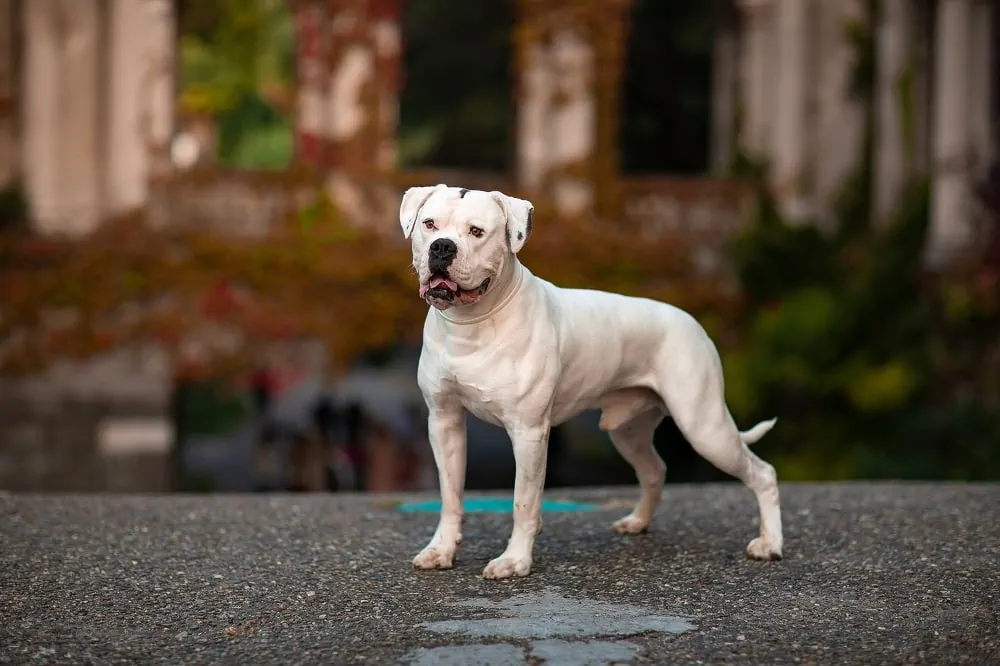
The American bulldog is a descendant of the English bulldog, which first appeared in American as early as the 17th century. When immigration increased in the 1800s, many newcomers brought their hard-working bulldogs along with them as they settled in the new country.
These bulldogs were popular with farmers and ranchers, who used them as all-around utility dogs. They were good at hunting and chasing down wild animals that threatened the farm.
They were excellent guard dogs as well. Their impressive strength and bravery meant they wouldn’t back down from even much larger animals, which made them invaluable when faced with outside threats like feral pigs, for example (source).
Feral pigs were the result of travelers to the newly-formed United States bringing pigs along with them as a source of food.
Unfortunately, there were no natural predators of these pigs in America, so they thrived and became quite a nuisance, especially in the South. For this reason, sturdy dogs like the English bulldog were indispensable.
As with many other breeds, the popularity of the English bulldog declined in the early part of the 20th century.
As men went off to fight in World War I and World War II, and as families moved away from large farmsteads to more urban environments, there wasn’t as much of a use for sturdy farming and hunting dogs.
In the southern U.S., where farming and fishing remain common even today, the breed managed to stick around.
By the end of World War II, the English bulldog breed was nearly extinct. The revival, and therefore the establishment of the American bulldog can be credited to John D. Johnson and Alan Scott.
These two men set out around the South looking for bulldogs with ideal characteristics, and by breeding English bulldogs with other types of bulldogs, the American bulldog was born.
You may hear the breed referred to by several other names besides American bulldog. The most common of the alternative names is the southern white bulldog, but most commonly it’s just called “bulldog”.
Characteristics of the American Bulldog
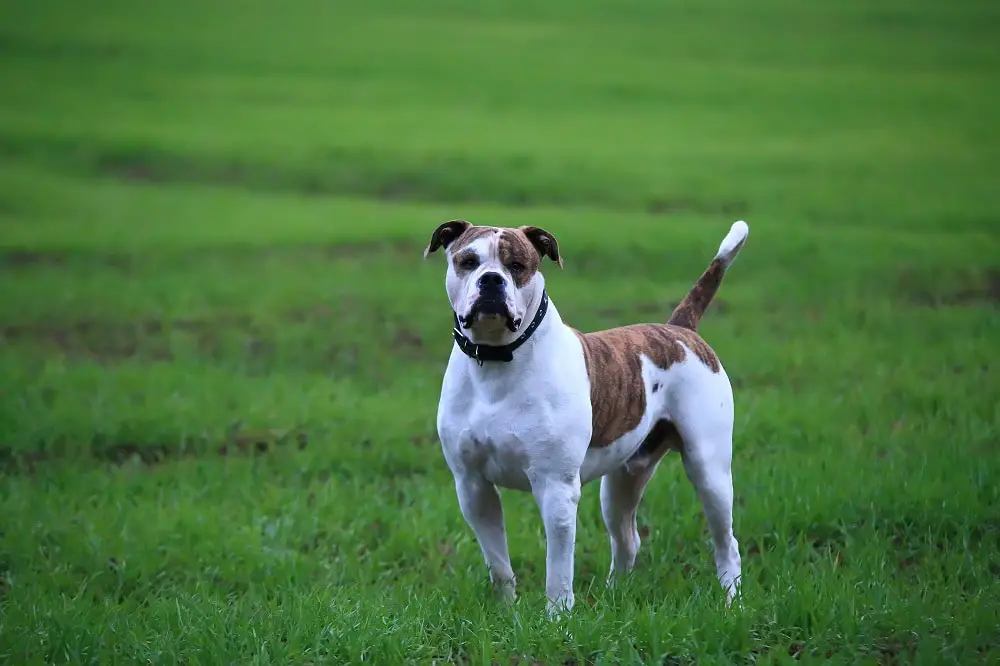
While the American bulldog has a lot in common with other bulldogs as well as pit bulls, they are a distinctive breed with their own distinctive traits. Let’s break down the characteristics of the American bulldog.
Physical Characteristics
The American bulldog is a very muscular dog with a large head and strong jaws. They can weigh between 60 and 120 pounds, which is a pretty large range, but that includes both males and females, and the females tend to be smaller than the males. Likewise, their height can range from 20 to 28 inches for a fully grown adult dog.
Their short, smooth coat can come in any range of colors, though most commonly they are white with patches of brown, black, or red. Their noses often have patches of black or pink, and you may see these colors around their eye as well.
Behavioral Characteristics
As with many active breeds, they need early training and socialization. Assuming care is taken in that regard, they are gentle, affectionate pets.
They are often referred to as “big lapdogs” due to their affectionate nature. They are good with children and other pets but should be monitored when being introduced to a new person or pet just to be on the safe side.
They are brave and strong-willed, which makes them ideal guard dogs. Be prepared to establish yourself as the leader of the pack, however, or this strong-willed nature may lead to behavior problems down the road.
Caring for an American Bulldog
American bulldogs are active dogs that require a good bit of mental and physical exercise in order to remain healthy and happy.
A good bit of outdoor time, with space to run and play, is advised, but at the least, they should be taken on long walks daily.
Their short coats do not require regular grooming, but they can shed quite a bit depending on the time of the year, so brushing occasionally will help keep your home and clothes fur-free.
They’re also prone to drooling, so they may not be the best choice for those who suffer from dog allergies.
As with any dog, high-quality dog food is the best diet for your American bulldog. They do not require any special food, but should not be fed table scraps or old food (link to spoiled meat article).
Health of the American Bulldog
The American bulldog is generally considered to be a hardy and healthy breed. Their average lifespan is between 10 and 16 years.
As they are active dogs, exercise is an important part of keeping the American bulldog healthy. Obesity early in life can contribute to joint problems later in life.
However, even given their healthy nature, there are a few genetic issues that can arise, such as hip and elbow dysplasia, ACL tears, and neuronal ceroid lipofuscinosis, which is a nervous system disorder that affects the eyes.
Due to their short snouts, breathing issues may occur, particularly during hot weather. Always be sure your bulldog has access to plenty of fresh water when exercising to keep them cool (source).
History of the Pit Bull
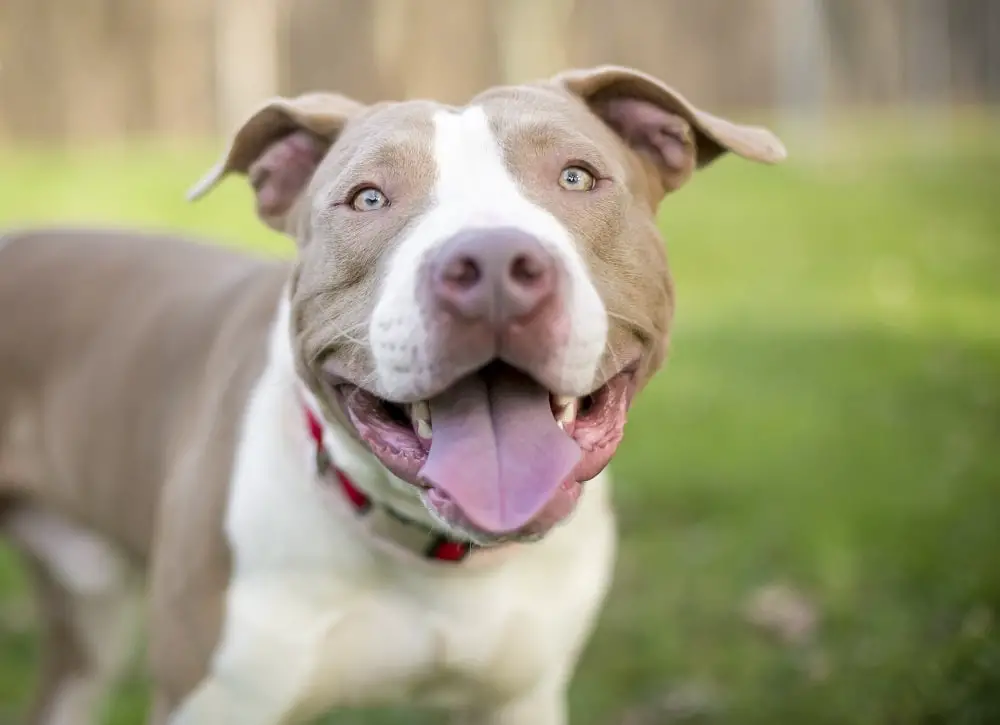
The pit bull can be traced back to the cruel and violent sport of bull-baiting. In the United Kingdom in the 1800s, English bulldogs were crossbred with terriers to create strong, tenacious, and aggressive dogs for the sport, where one or two dogs would torment a bull (or sometimes a bear) until the bull collapsed from its injuries.
Once bull-baiting was outlawed, they were used in dog fighting, which was much easier to hide away and do in secret than bull baiting.
Immigrants brought pit bulls to America in the late 1800s, where their bravery and strength were valuable assets for frontiersmen and farmers alike.
Many of the traits that had made them ideal fighters were also ideal for being an all-around work dog in the new world.
Renamed the American pit bull terrier, they became a sort of national mascot during World War I and World War II due to their bravery and loyalty, traits soldiers on the battlefield could relate to.
Their aggressive reputation comes from their long history with blood sports such as bull-baiting and dogfighting. While it’s true they can be trained to be aggressive for those violent activities, with proper training they can be gentle, loving companions.
Dogfighting was outlawed in the United States in 1976 with the passage of the Animal Welfare Act. It is now a felony in all 50 states. But as the practice was pushed underground, people began to seek out pit bulls and train them specifically for illicit activities.
Pit bulls became associated with criminals, and the national media contributed to this with sensational stories such as Time Magazine’s article from 1987 titled “The Pit Bull: Friend and Killer”, and Sports Illustrated’s article from the same year titled “Beware of This Dog”.
These stories, and others, played up the animal’s aggressive reputation and contributed to a culture of fear surrounding the animal (source).
Though this reputation still follows the pit bull to this day, there is no scientific evidence to suggest they are instinctually any more aggressive than other dog breeds. As with all dogs, it’s all in how they are trained.
Characteristics of the Pit Bull
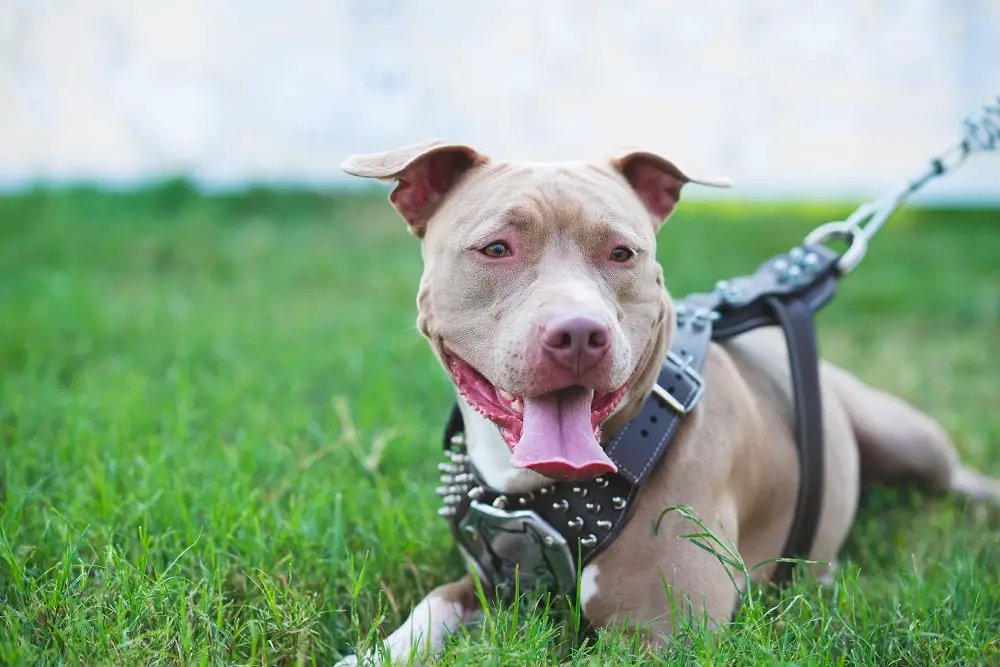
Seeing that they are essentially a cross between a bulldog and a terrier, it makes sense that pit bulls share traits with many of those breeds. But they are a distinctive breed with their own characteristics.
Physical Characteristics
Pit bulls are stocky and muscular dogs, but quite fast and agile. They’re known for being good climbers as well.
Their heads are broad and flat, but proportionate to their body, and their ears are usually medium-sized and set high on their heads. Their wide, strong jaw is one of the defining characteristics of the pit bull.
Their coat is smooth and stiff and can come in a wide variety of colors. Due to the various terriers in the pit bull’s bloodline, their size can vary quite a bit. Smaller pit bulls maybe around 30 pounds, while on the large end they can weigh as much as 90.
Their height is usually more uniform, finding most Pitbulls in the 17-19 inches range (source). This means that despite their similar appearance to the American bulldog, they are quite a bit smaller.
Behavioral Characteristics
The pit bull is an active, energetic dog that loves to play. They are brave and strong-willed, but also have a strong desire to please their owners.
They can be affectionate dogs and are generally good with children if socialized properly. Always monitor their behavior when introducing them to new people or animals until you know how they will react.
They do have a strong preying instinct, however, so it’s important to socialize and train them when they are young to avoid having them chase down smaller animals. This is especially important if you have other pets in the home.
Their protective nature can be a drawback if they aren’t trained properly. They want to please their owners, which can lead to being overprotective.
While this quality is why they are sometimes used as guard dogs, it’s important that your pitbull know when you need protecting and when you’re simply having a guest over.
Caring for a Pit Bull
Pit bulls need a great deal of exercise every day. If you’re an apartment dweller who wants a dog you can leave in your apartment all day while you’re at work, then the pit bull may not be for you.
They thrive when they have plenty of room to run around. Just a simple walk around the block is not going to be enough vigorous exercise to keep your pit bull happy and healthy, and when they grow bored they may exhibit destructive behavior.
Due to their high need for exercise, it’s important to feed them high-quality dog food and to not overfeed them. They should not eat table scraps or leftovers, as this can contribute to obesity.
Their short coat doesn’t need professional grooming. The amount of shedding will vary from dog to dog, but regular brushing should keep excess fur from accumulating around your home (source).
While it’s important for your pit bull to have plenty of outside room to run and play, care must be taken to keep them safe in your yard.
They are excellent climbers, so good fencing is a must. The last thing you want is for your dog to climb and escape from your yard. While no one wants their dog to escape, regardless of breed, this can be especially perilous for pit bulls due to the fear that sometimes surrounds them.
Health of the Pit Bull
Pit bulls are a hearty and generally healthy breed. Their lifespan averages between 12 and 14 years, which is pretty comparable to that of the American bulldog.
While there are a few genetic conditions that can crop up, most are mild and treatable, such as hip dysplasia and arthritis.
Much like the American bulldog, they are prone to skin allergies due to their short coat. They also share a predisposition to neuronal ceroid lipofuscinosis with the American bulldog.
One advantage the pit bull has over the American bulldog is that it is not known for excessive drooling. This is great news for allergy sufferers, not to mention those who would just prefer to not have dog slobber all over their stuff.
For a quick review, find out which of the two is best for you in this short video below:
Legal Issues
One area where pit bulls stand apart from most other breeds is their legal status. Due to their reputation as aggressive dogs, there are many laws on the books that relate to ownership.
In some places, this means things like mandatory sterilization, while many cities have outright banned the owning pit bulls altogether. They are also banned on all U.S. military bases.
The legal status of pit bulls is a contentious issue, with those on one side insisting it is necessary for the safety of the citizens and those on the other side saying it unfairly maligns a dog that has no more of a predisposition to aggression than other breeds (source).
The city council in Denver, Colorado recently voted to overturn its ban on pit bulls, which has been in place since 1989.
This led to much rejoicing from those who wish to own one. However, Mayor Michael Hancock vetoed the measure, so the pit bull remains illegal in the city. This is just one example of how many people still fail to see eye-to-eye when it comes to these dogs.
Final Thoughts
Given that the American bulldog and the pit bull have common ancestors, it makes sense that they are similar in appearance and temperament.
There are some key differences between the two, however. The American bulldog is larger than the pit bull but isn’t quite as agile. Both dogs can be quite affectionate and loving, but the American bulldog is less likely to be overprotective of its owner.
Their reputations are quite different as well, though many would argue that the pit bull is no more aggressive than the American bulldog (and science would back up that claim).
There is a lot to consider when choosing between these two breeds. If you are a novice dog owner, the American bulldog is probably a safer bet, as they do not require as much training and socialization as the pit bull. There are also fewer legal hurdles to jump through, depending on where you live.
However, if you have the room for a pit bull to run and exercise, and you have the patience to properly train and socialize them, the pit bull can be a wonderful, loving companion.
Also, those who are allergic to the proteins in dog saliva may find the pit bull to be the better option, as long as it is legal to own one in their city. The important thing is to assess your needs and your ability to properly care for the dog.

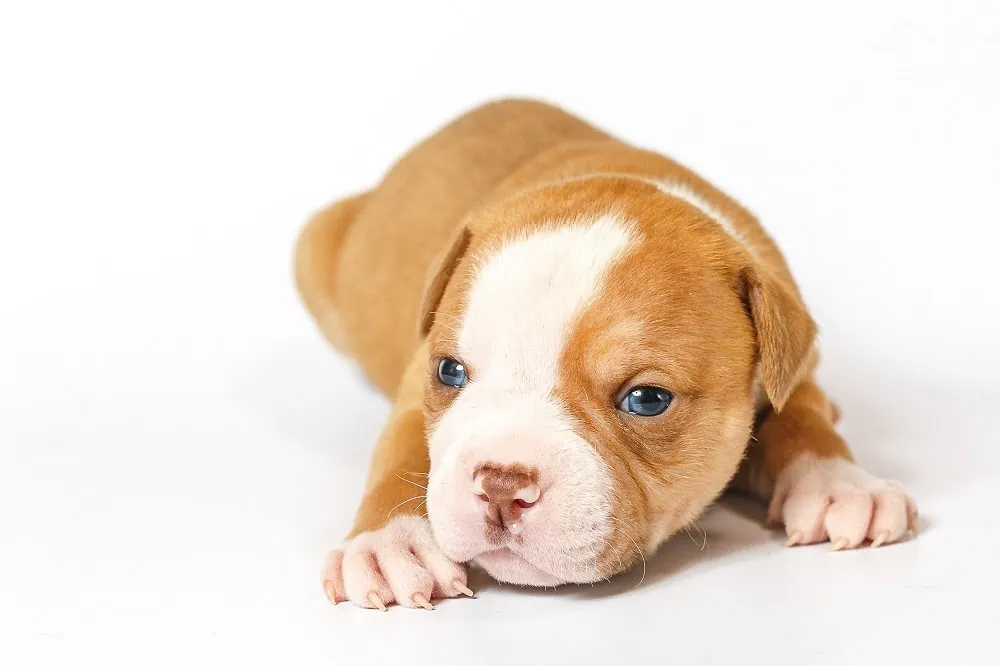
0 Comments